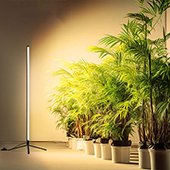
Menu
We often receive inquiries from new customers who are curious about how red light impacts plants and the effects of far red light.
You are likely familiar with the importance of red light in plant growth, but do you know precisely where its impact lies?
Today, we are here to explore the incredible effect of red light on plant growth and contemplate whether plants can thrive by relying solely on it for their development.
Plants use photosynthesis to convert light energy into chemical energy, fueling their growth. Chloroplasts are the primary site where the process of absorbing light takes place, facilitated by pigments like chlorophyll.
Red light is crucial for plant growth as chlorophyll pigments absorb it more efficiently than other wavelengths. Plants undergo enhanced photosynthesis and better health in response to sufficient red light.

Red light affects your plants in several ways. One of the main benefits is that it sends a message to your plants to tell them the best time to bloom.
Seed Germination.
The presence of red light is crucial for successful seed germination. Without it, the biochemical processes necessary to initiate plant growth cannot occur.
Stimulation of Photosynthesis.
When plants receive sufficient red light, the photosynthesis rate increases. This results in more sugar and carbohydrates, promoting strong plant growth.
Stem Elongation and Flowering.
Red light also affects the morphology of plants, specifically on their stem elongation and flowering. Plants exposed to red light exhibit stem elongation, known as the “far-red response”. It is essential for the transition of plants from asexual to reproductive growth, promoting the development of flowers and fruits.
Improve the Flavor of Plants.
When exposed to red light, the concentration of specific oils within a plant increases, thereby affecting the plant’s flavor profile. Plants exposed to more red light may taste bitter.
Far Red Light promotes stem elongation and internode spacing in plants, affecting their overall form and canopy structure.
It enhances plant growth by promoting flowering and leaf expansion, increasing surface area for photosynthesis. Some studies have shown that far-red light even helps increase the effectiveness of the PAR spectrum.
Far-red light has recently become a buzzword in marijuana cultivation. However, growers have acknowledged the value of red light for developmental yields, but only recently have researchers been able to study this effect on regulated crops legitimately.
Marijuana aside, plant scientists have long believed that most plant species use photosynthetically active radiation (PAR) for photosynthesis. Traditionally, PAR describes photons traveling between 400 and 700 nm wavelengths, closely related to the narrow band of light visible to humans.
However, research on far-red supplementation of traditional crops, such as tomatoes and lettuce, is slowly beginning to change the scientific view of PAR. For example, research has determined that far-red light grows larger tomatoes and increases the total biomass of lettuce.
Recently, Utah State University researchers Shuyang Zhen, Marc W. van Iersel, and Bruce Bugbee published Photosynthesis in Photosynthesis in sun and Shade: The Surprising Importance of Far-Red Photons. Their findings amount to nothing less than a paradigm shift in the indoor cannabis industry.
In an interview with Cannabis Business Times, Bugbee also said, “In addition to photosynthesis, far-red photons are a powerful tool to manipulate plant shape.”
Without a doubt, red light is crucial for plant growth. However, the current spectrum provided is not optimal for their development.
If you use only red light for your plants, they may grow tall and bushy, but their branches and foliage may become thin and spiky. This is the reason that unlocks the full potential with a powerful combination of red and blue light.
Blue Light for Chlorophyll Synthesis.
Blue light is essential for chlorophyll synthesis and promoting plant health and growth. Combining blue and red light creates a balanced spectrum that supports plant growth and flowering.
White Light for Balanced Growth.
White light consists of all visible wavelengths, which creates a more balanced spectrum and mimics natural sunlight. It ensures that plants have access to a wide range of wavelengths needed for physiological processes, from photosynthesis to nutrient uptake.
Red light is essential for plant growth, promoting stem elongation, flowering, and seed germination through photosynthesis. However, plants require a balanced spectrum to meet their photosynthetic needs.
We are experts in producing top-quality LED grow lights designed to cater to each plant’s unique growth stages. We understand the importance of carefully crafting lighting solutions that only use a combination of wavelengths beneficial for plant growth. This is what creates fresh, green, and healthy crops.
From custom light planning, to tailored quotes, and everything in between, our team of horticulture experts are always ready to assist.
Vanten LED
Guzhen, Zhongshan, Guangdong, China
WhatsApp: +86 180 2409 6862
Email: info @ vantenled.com
We are a professional LED plant light manufacturer, committed to using technology to enhance the maximum potential of the lamp, continuously maximizing the benefits for growers, and saving energy for the planet.



